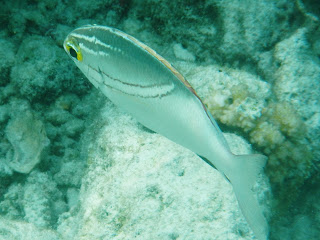Crescent-tail
Bigeye (Priacanthus hamrur): Bigeyes, also
called Goggleyes or Bullseyes are nocturnal. Hence the
especially large eyes to make the most of the dim light. During the
day they hang suspended off the reef face often with their mouths
open filtering-out the zooplankton and fish larva swept in by the
ocean currents. As daylight fades they start feeding on
bottom-dwelling invertebrates like crustaceans. Growing to 35 cm,
Bigeyes are mostly seen in their red livery but they can rapidly
change colour to plain silver, or when the mood takes them silver and
red bars.
Snorkelling in the Maldives
white tip shark

Welcome!
Hi everyone,
Welcome to Snorkelling in the Maldives, a blog designed to enable any snorkeller or scuba diver, whether novice or experienced, to get maximum pleasure from a trip to the Maldives. Many posts will concern the easy identification of the fish you see there as well. The one above is a Whitetip Reef Shark, the most widespread shark species on the Maldivian Reefs.
Our snorkelling career started in Australia's Hayman Island 20 years ago. Since then we have been fascinated by the world beneath the waves. We have snorkelled in Lord Howe, Australia, and seen the southern-most reach of the soft corals. We have bobbed in Brampton and Heron Islands in the Australian Whitsundays on the Great Barrier Reef, swum round Michaelmas Key in Cairns, dived in Indonesia and the Gilli Islands, sampled the warm waters of the south seas in Vanuatu, Rarotonga, New Caledonia and Fiji and explored the reefs of the Maldives in the Indian Ocean. And never once did the underwater world lose its fascination. We are hooked on the Maldives and keep coming back - twice a year to atolls that seem to feature more exotic and rare fish than anywhere else.
Welcome to Snorkelling in the Maldives, a blog designed to enable any snorkeller or scuba diver, whether novice or experienced, to get maximum pleasure from a trip to the Maldives. Many posts will concern the easy identification of the fish you see there as well. The one above is a Whitetip Reef Shark, the most widespread shark species on the Maldivian Reefs.
Our snorkelling career started in Australia's Hayman Island 20 years ago. Since then we have been fascinated by the world beneath the waves. We have snorkelled in Lord Howe, Australia, and seen the southern-most reach of the soft corals. We have bobbed in Brampton and Heron Islands in the Australian Whitsundays on the Great Barrier Reef, swum round Michaelmas Key in Cairns, dived in Indonesia and the Gilli Islands, sampled the warm waters of the south seas in Vanuatu, Rarotonga, New Caledonia and Fiji and explored the reefs of the Maldives in the Indian Ocean. And never once did the underwater world lose its fascination. We are hooked on the Maldives and keep coming back - twice a year to atolls that seem to feature more exotic and rare fish than anywhere else.
Slideshow
Monday, December 10, 2012
Wednesday, November 21, 2012
Moon Wrasse:
(Thalassoma lunare) Very inquisitive towards snorkellers, the 22cm Moon Wrasse features a
body vertically-lined with incomplete red. It varies in colour from
dark green for the females to bright blue for the males and has pink
bands radiating from the eyes. The pectoral fins of the male often
feature bright colours.
Tuesday, November 13, 2012
Scribbled
Leatherjacket: (Aluteres scriptus) What a
wonderfully evocative name this member of the Filefish family has. It
is not at all common in the Maldives but you will know it if you are
lucky enough to see it. It averages 60 cm but can grow to a metre in
length – a third of which is its extremely long tail. It is
beautifully coloured in pale blue and yellow with plenty of black
spots. It has an extremely varied diet including hydrozoa, sea
anemones, gorgonias, tunicates and algae.
Sunday, November 4, 2012
Friday, November 2, 2012
Sergeant Major:
(Abudefduf vaigiensis) Named after the stripes it carries, the Sergeant Major, which can
grow up to 15 cm, is very common in the Maldives. It will form large
schools off the deep drop-off. Easily recognised by its four vertical
thick blue stripes on a silver body with yellow blotches in between
on the upper back. At spawning time the male prepares a nest on a
bare patch of hard bottom that the female fills with as many as
25,000 eggs. These hatch a week later.
Tuesday, October 30, 2012
Porcupine
Ray
(Urogymnus
asperrimus):
The strange-looking Porcupine Ray is not a resident of the Maldives
but is a frequent visitor. Covered with plate-like tenticles and
sharp thorns, it is also known as the Roughskin Stingaree,
Rough-skinned Ray, Solander’s Ray and Thorny Ray. The Porcupine Ray
has an oval-shaped disc that can be up to a metre in disc width. Its
dark-tipped tail with its dark tip lacks stinging spines and skin
folds. The Ray's colour is whitish-grey to brown above and white
below. This one was photographed in the lagoon of Biyadhoo Atoll.
Wednesday, October 24, 2012
Two-lined Monacle
Bream (Scolopsis bilineata): A frequently-seen inhabitant of
the Lagoon’s rubble area, the 20 cm Two-lined Monacle Bream looks
as though it can’t make up its mind. It darts from one place to
another stopping dead each time in a questioning way. In fact it has
excellent eyesight and looks for signs of worms and small creatures
in the rubble and sand. The slightest movement .. and lunch is
served. Look for a grey body, the distinctive white head-stripe
outlined in black that runs from under the eye to the middle of the
back, the outsized eye and the darkened skin under the dorsal fin.
Subscribe to:
Comments (Atom)






